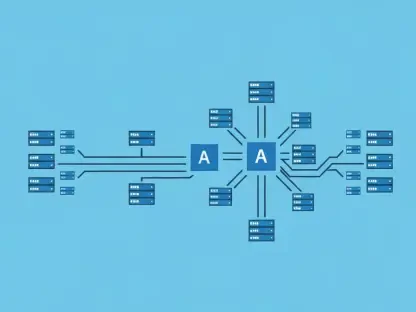In today’s fast-paced work environment, finding the right workflow management software can transform chaos into clarity, especially when teams are juggling multiple projects across different time zones or locations. The sheer volume of available tools can be overwhelming, with each promising to boost productivity and streamline operations. Yet, not every solution aligns with every team’s unique challenges, whether it’s a small startup seeking cost-effective options or a large enterprise needing robust scalability. This exploration focuses on top-tier platforms like ClickUp, Monday.com, Miro, Qntrl, and FigJam, dissecting their features, strengths, and fit for various organizational needs. By delving into what sets these tools apart, the goal is to provide clear guidance on selecting a system that enhances collaboration, reduces manual effort, and keeps projects on track. From automation to visual planning, the right choice hinges on understanding specific priorities and constraints, ensuring that technology serves as a true enabler rather than a hindrance.
The journey to pinpointing the ideal software begins with a deep dive into key considerations and detailed analyses of leading options. Each platform offers distinct advantages, catering to different aspects of workflow management, from real-time teamwork to intricate customization. Beyond just features, factors like budget, ease of use, and compatibility with existing tools play critical roles in the decision-making process. This comprehensive breakdown aims to simplify the selection by aligning software capabilities with team dynamics and project goals. Let’s start by examining the foundational elements to consider before committing to a solution.
Key Considerations When Choosing Workflow Software
Identifying Core Team Requirements
When embarking on the search for workflow management software, the first step lies in clearly defining what a team truly needs to thrive in its day-to-day operations. Is the primary focus on fostering seamless collaboration across remote members, or does the emphasis rest on automating repetitive tasks to save time? Platforms like ClickUp stand out for their real-time teamwork features, enabling instant updates and shared task visibility, which are invaluable for distributed groups. On the other hand, Monday.com provides extensive customization options, allowing processes to be tailored to precise project specifications. For teams reliant on creative brainstorming, Miro’s visual tools, such as an expansive canvas for mind maps, might be the perfect fit. Meanwhile, Qntrl addresses scalability, catering to organizations with growing or complex demands. Pinpointing whether the priority is interaction, flexibility, creativity, or expansion ensures that the chosen tool directly addresses the most pressing pain points, avoiding the trap of adopting a system that looks impressive but fails to deliver on core necessities.
Beyond just identifying needs, it’s essential to consider how a tool aligns with the team’s working style and long-term objectives, ensuring a seamless fit for both current and future demands. Some groups may require software that supports intricate workflow structures, like parallel or rules-based processes, which Qntrl and Monday.com handle adeptly. Others might prioritize simplicity to ensure quick adoption without extensive training, a strength of FigJam with its intuitive whiteboard interface. Assessing the nature of projects—whether they’re linear, dynamic, or highly collaborative—helps narrow down options. Additionally, factoring in future growth prevents the need for frequent tool changes, which can disrupt operations. A mismatch between software capabilities and team habits can lead to frustration, so taking the time to map out daily routines and pain points against what each platform offers is a critical exercise. This approach ensures that the selected solution not only solves immediate issues but also supports sustained efficiency as demands evolve.
Balancing Budget and Accessibility
Cost often emerges as a pivotal factor when selecting workflow software, as teams must weigh financial constraints against the value a tool provides, making it crucial to find the right balance. Fortunately, many leading platforms offer free plans or trial periods, making it easier to test functionality without upfront investment. FigJam, for instance, provides free access to basic features, which suits smaller teams or those just starting out. Similarly, both ClickUp and Monday.com include no-cost options for limited users, allowing experimentation with core capabilities. For organizations anticipating growth, Qntrl presents an affordable paid plan starting at $8 per user per month following a 15-day trial, balancing cost with advanced features. Evaluating whether a tool’s paid tiers unlock essential functionalities or if free versions suffice for current needs is a practical step. This ensures that budgets aren’t stretched thin on features that remain unused, while still securing a solution that delivers measurable benefits.
Accessibility extends beyond price to how easily a tool can be adopted across a team, regardless of technical expertise. Software with steep learning curves can hinder productivity if users struggle to navigate interfaces or leverage key features. Most options, like ClickUp and FigJam, prioritize user-friendly designs, minimizing onboarding time, but it’s worth noting any potential complexities, especially in tools with extensive customization like Monday.com. Trial periods become invaluable here, offering a risk-free way to assess whether a platform’s interface and support resources align with team capabilities. Additionally, considering mobile app availability, as seen with Monday.com, ensures accessibility for on-the-go members. Striking a balance between affordability and ease of use prevents the pitfalls of overspending or adopting a tool that frustrates rather than empowers, setting the stage for a smooth integration into daily workflows.
Top Workflow Software: Features and Fit
ClickUp: Collaboration Powerhouse
ClickUp has carved out a reputation as a leading choice for teams where collaboration is the heartbeat of productivity, boasting an impressive user rating of 4.7 out of 5. This platform offers an all-in-one environment with features like customizable triggers and integrated forms, making it adaptable to a wide array of project types. Its real-time updates and shared task views ensure that every member stays aligned, regardless of location, which is particularly beneficial for remote or hybrid setups. A 14-day free trial, coupled with a no-cost plan for smaller teams, allows for thorough testing without financial commitment. For groups prioritizing seamless interaction and the ability to manage diverse tasks under one roof, ClickUp emerges as a versatile and reliable option that minimizes communication gaps and keeps projects moving forward with clarity.
Another strength of ClickUp lies in its ability to cater to varying levels of complexity within team workflows, ensuring it doesn’t overwhelm users while still offering depth for those who need it. Beyond basic task tracking, the platform supports automation of routine processes, freeing up time for strategic focus. Its intuitive interface lowers the barrier to entry, meaning even less tech-savvy team members can quickly get up to speed. While the free plan covers essentials, paid tiers unlock advanced reporting and additional integrations, which can be crucial for larger teams with intricate needs. The balance of accessibility and robust functionality makes ClickUp a standout for organizations aiming to foster teamwork without sacrificing efficiency. Testing it through the trial period can reveal how well it meshes with specific collaboration styles, providing confidence in its fit before any long-term investment.
Monday.com: Customization King
With a strong user rating of 4.6 out of 5, Monday.com positions itself as a frontrunner for teams that require high levels of customization to match unique project demands. The platform’s unlimited boards allow for the creation of tailored workflows, ensuring processes reflect exact organizational goals rather than forcing adaptation to rigid templates. AI-driven automation further enhances efficiency by handling repetitive tasks, while a mobile app extends accessibility for teams on the move. A free plan for smaller groups or freelancers provides an entry point to explore its capabilities without cost. For those who need a system that bends to their specific operational style, Monday.com offers a compelling mix of flexibility and power, making it a top consideration in the workflow management space.
Delving deeper, Monday.com’s strength in customization is complemented by a visually appealing and relatively straightforward interface, though its mobile app may lack some desktop features. The ability to build workflows from scratch or tweak existing ones means that teams in dynamic industries can pivot quickly as needs change. Integration with popular tools enhances its utility within existing tech stacks, while AI features suggest optimizations that might otherwise be overlooked. For growing businesses, paid plans introduce scalability, though smaller teams might find the free version sufficient for basic needs. Evaluating Monday.com through its trial or free offering can clarify whether its customization depth justifies the investment, especially for teams with highly specialized processes that standard tools can’t accommodate. This adaptability ensures it remains relevant even as project scopes evolve over time.
Miro: Visual Planning Made Easy
Miro distinguishes itself as the ideal platform for teams whose work thrives on visual creativity and brainstorming, offering an infinite canvas that serves as a boundless workspace for ideas. With over 1,000 templates for mind maps, flowcharts, and Kanban boards, it caters to strategic planning and design-oriented projects with ease. Features like voting and commenting foster collaborative input in real time, making it a dynamic hub for group ideation. Integration with tools such as Notion and Asana ensures it fits into broader ecosystems, amplifying its utility. For teams in creative fields or those reliant on mapping out complex concepts visually, Miro provides an unmatched environment that encourages innovation and clarity in planning stages.
Beyond its visual prowess, Miro’s AI-assisted canvas structuring adds a layer of intelligence to how teams organize thoughts and workflows, saving time on manual adjustments. Its accessibility across devices means that ideas can be captured or refined anytime, anywhere, which is crucial for fast-paced or distributed teams. The platform’s emphasis on interactive elements, like sticky notes and shared boards, keeps engagement high during collaborative sessions. While it excels in creative planning, teams with more operational or data-heavy needs might need to pair it with another tool for full workflow coverage. A free plan allows exploration of its core features, ensuring that potential users can assess its fit for visual tasks without upfront costs. Miro’s unique approach to workflow visualization makes it a valuable asset for industries where seeing the big picture is as important as executing the details.
Qntrl: Scalable Automation for Growth
Developed by Zoho Corporation, Qntrl targets organizations that require automation at scale to manage intricate processes efficiently, starting at a reasonable $8 per user per month after a 15-day free trial. Its customizable templates and task hierarchies enable the design of workflows that align with specific business rules, making it suitable for larger teams or those with compliance needs. A strong focus on data privacy addresses concerns for sensitive operations, ensuring security alongside functionality. For enterprises or growing businesses seeking a balance of affordability and powerful automation, Qntrl stands as a practical solution that supports operational efficiency without compromising on critical safeguards.
Further examination reveals Qntrl’s knack for handling complexity through features like automated approvals and detailed reporting, which streamline oversight in multi-layered projects. Its scalability ensures that as team size or project scope increases, the tool adapts without necessitating a full system overhaul. Integration within the Zoho ecosystem adds value for users already leveraging related apps, though it also supports standalone use. The emphasis on privacy and rule-based automation makes it particularly appealing for industries with strict regulatory demands. Testing Qntrl during its trial period can help determine if its structured approach matches the operational rhythm of a team, especially for those prioritizing long-term growth over short-term simplicity. This focus on sustainable efficiency positions it as a forward-thinking choice in workflow management.
FigJam: Simplicity for Creative Teams
FigJam rounds out the selection with a focus on simplicity and flexibility, offering a free plan and an interactive whiteboard interface that excels in workflow mapping for creative industries. Its seamless integration with Figma enhances its appeal for design-focused teams, while real-time collaboration tools like voting keep group input fluid and engaging. The platform’s ease of use ensures quick adoption, even for those unfamiliar with workflow tools, making it ideal for smaller teams or projects centered on ideation. If a straightforward, no-frills approach to visual collaboration is the goal, FigJam delivers an accessible and effective solution that prioritizes user experience over complexity.
Additionally, FigJam’s strength lies in its ability to keep things light yet functional, avoiding the bloat of unnecessary features that can bog down other platforms. Its whiteboard format encourages free-form planning, which can be particularly useful in early project stages where structure is less defined. While it may lack the depth of automation or customization found in tools like Monday.com or Qntrl, its niche in creative simplicity fills a vital gap for teams not needing heavy operational tools. The free access lowers the barrier to entry, allowing experimentation without financial risk. For organizations where visual interaction trumps intricate process management, FigJam provides a refreshing, user-centric option that integrates smoothly into design workflows, ensuring ideas flow freely without technical friction.
Broader Workflow Management Insights
Decoding Different Workflow Structures
Understanding the type of workflow a team operates within—whether sequential, parallel, state machine, or rules-based—is fundamental to selecting software that supports rather than hinders processes. Sequential workflows, where tasks follow a linear path, are well-served by platforms like ClickUp, which offer clear task progression tracking. Parallel workflows, involving simultaneous activities, benefit from Monday.com’s ability to manage multiple streams via customizable boards. State machine workflows, with defined stages, align with Miro’s visual mapping for status clarity. Qntrl excels in rules-based setups, enforcing specific conditions through automation. Matching software to workflow structure prevents bottlenecks and ensures that the tool enhances natural operational flow, making it a seamless extension of existing practices rather than a forced fit.
Diving deeper, the impact of mismatched software on workflow efficiency cannot be overstated, as it can lead to delays or miscommunication if the tool lacks the necessary flexibility or structure. For instance, a creative team using a rigid, rules-heavy platform might stifle innovation, while a highly regulated team on a free-form tool could miss critical compliance steps. Beyond type, considering the volume and frequency of tasks within these structures helps refine the choice—high-volume environments may need Qntrl’s automation, while sporadic, idea-driven workflows suit FigJam. Educational resources or trial periods offered by these platforms can aid in mapping workflows before selection. This analytical step ensures that the chosen solution not only fits current processes but also provides room for adaptation as project demands shift, maintaining long-term relevance in a dynamic work landscape.
Ensuring Compatibility and Integration
No workflow tool operates in a vacuum, making integration with existing applications a critical consideration for maintaining operational harmony. Miro connects effortlessly with platforms like Asana and Notion, ensuring that visual planning ties into broader project tracking. FigJam’s link with Figma is a boon for design teams already in that ecosystem, streamlining creative processes. While a dedicated Google workflow tool remains absent, third-party solutions like Zapier bridge gaps with Google Workspace for basic task automation. Evaluating how well a platform syncs with current tech stacks prevents data silos and redundant work, ensuring that information flows smoothly across systems for maximum efficiency.
Equally important is the potential for integration to enhance rather than complicate workflows, as poorly connected tools can create more friction than they resolve. ClickUp and Monday.com offer wide-ranging compatibility with popular apps, reducing the need for manual data transfers that drain time and invite errors. For teams with niche or custom software, checking API availability or custom integration options becomes essential, as seen with Qntrl’s business-focused connections. Testing integrations during trial phases can reveal real-world performance, confirming whether promised connectivity holds up under actual use. Prioritizing compatibility not only preserves existing efficiencies but also amplifies the value of a new tool by embedding it deeply into daily operations, creating a cohesive digital environment that supports rather than disrupts team momentum.









